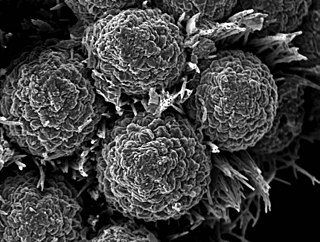Related Research Articles
Jobellisia is a genus of fungi within the monotypic family Jobellisiaceae and the monotypic order Jobellisiales and also the subclass Hypocreomycetidae, and class Sordariomycetes. The genus was circumscribed by Margaret Elizabeth Barr-Bigelow in 1993 with Jobellisia luteola as the type species. It contains species that grow on dead wood and bark in tropical and temperate regions of the Northern Hemisphere.
The Koralionastetaceae are a family of fungi in the Ascomycota phylum. This family was taxonomically classified into class of Sordariomycetes and order of Koralionastetales and subclass Lulworthiomycetidae.
The Trichosphaeriales are an order of sac fungi. It is monotypic, and consists of the single family, the Trichosphaeriaceae. In 2017, the family of Trichosphaeriaceae was placed in Diaporthomycetidae families incertae sedis, which was accepted by Wijayawardene et al. (2018), and Wijayawardene et al. 2020. The order of Trichosphaeriales was also unplaced. They are generally saprobic and pathogenic on plants, commonly isolated from herbivore dung.
Endoxyla is a genus of fungi within the Boliniaceae family.
Ascotaiwania is a genus of fungi in the Sordariomycetes class of the Ascomycota. In 2020, it was placed in the order Savoryellales and family of Savoryellaceae.
Spinulosphaeria is a genus of fungi in the Sordariomycetes class of the Ascomycota. It was placed in 2020, within the Order Coronophorales and in the family of Chaetosphaerellaceae.
Aquaticola is a genus of fungi in the Cephalothecaceae family of the Ascomycota. The relationship of this taxon to other taxa within the Sordariomycetes class is unknown, except that it is in subclass Diaporthomycetidae, and it has not yet been placed with certainty into any order.
Cyanoannulus is a fungal genus in the family Annulatascaceae of the Ascomycota. This is in the monotypic order of Annulatascales of the class Sordariomycetes. It was formerly classed as Sordariomycetes class in 2007.
Fusoidispora is a fungal genus in the Annulatascaceae family of the Ascomycota. The relationship of this taxon to other taxa within the Sordariomycetes class is unknown, except that it is in subclass Diaporthomycetidae, and it has not yet been placed with certainty into any order. This is a monotypic genus, containing the single species Fusoidispora aquatica.

The Chaetosphaerellaceae are a family of fungi in the Ascomycota, class Sordariomycetes. The family was described in 2004. Species in the family have a widespread distribution, and are found in both temperate and tropical areas, where they grow saprobically on fallen wood.
Chaetosphaeria is a genus of fungi in the family Chaetosphaeriaceae.
Myrmecridium is a genus of fungi in the class Sordariomycetes. It was circumscribed in 2007 and is distinguished from similar fungi by having entirely hyaline (translucent) vegetative hyphae and widely scattered, pimple-shaped denticles on the long hyaline rachis. The generic name derives from a combination of the Ancient Greek word "myrmekia", meaning "wart", and the suffix "-ridium" from "Chloridium".
Conioscypha is a genus of terrestrial and freshwater fungi in the monotypic family Conioscyphaceae and the monotypic order Conioscyphales. They are found on decayed wood, leaves, or bamboo stems. Except for Conioscypha japonica which was isolated from dog skin fragments and hair in 2017.
Conioscyphales is an order of freshwater and terrestrial fungi within the division Ascomycota. It is in the subclass Savoryellomycetidae and the class Sordariomycetes and the subdivision of Pezizomycotina.
Fuscosporellales is an order of fungi within the phylum of Ascomycota and in the class Sordariomycetes and subdivision of Pezizomycotina.
Savoryellaceae is a family of aquatic based fungi. It is the only family in the monotypic order Savoryellales within the class Sordariomycetes, division Ascomycota.
Savoryella is a genus of freshwater and marine based fungi in the family Savoryellaceae and the order Savoryellales.
Pisorisporiales is an order of fungi within the phylum of Ascomycota and in the class Sordariomycetes and subdivision of Pezizomycotina and also its own subclass Pisorisporiomycetidae.
Pleurotheciaceae is a family of ascomycetous fungi within the monotypic order of Pleurotheciales in the subclass Savoryellomycetidae and within the class Sordariomycetes.
Pleurothecium is a genus of terrestrial and freshwater fungi in the family Pleurotheciaceae and the monotypic order Pleurotheciales. It is typified by Pleurothecium recurvatum as the type species (Morgan) Höhn, which has the synonym of Carpoligna pleurotheciiF.A. Fernández & Huhndorf, Mycologia 9: 253. 1999.
References
- 1 2 Réblová, Martina; Seifert, Keith A. (January 2004). "Conioscyphascus, a new ascomycetous genus for holomorphs with Conioscypha anamorphs". Studies in Mycology. 50 (1): 95–108.
- ↑ Lumbsch TH, Huhndorf SM. (December 2007). "Outline of Ascomycota – 2007". Myconet. 13. Chicago, USA: The Field Museum, Department of Botany: 1–58. Archived from the original on 2009-03-18. Retrieved 2015-09-23.
- ↑ "Species Fungorum - Names Record - Conioscyphascus gracilis (Munk) Réblová & Seifert, Stud. Mycol. 50(1): 104 (2004)". www.speciesfungorum.org. Retrieved 8 May 2023.
- ↑ Zelski, Steven E.; Raja, Huzefa A.; Miller, Andrew N.; Shearer, Carol A. (May 2015). "Conioscypha peruviana sp. nov., its phylogenetic placement based on 28S rRNA gene, and a report of Conioscypha gracilis comb. nov. from Peru". Mycoscience. 56 (3): 319–325. doi:10.1016/j.myc.2014.09.002.
- ↑ Réblová, M.; Miller, A.N.; Rossman, A.Y.; Seifert, K.A.; Crous, P.W.; Hawksworth, D.L.; Abdel-Wahab, M.A.; Cannon, P.F.; Daranagama, D.A.; De Beer, Z.W.; Huang, SK; Hyde, Kevin D.; Jayawardena, R.; Jaklitsch, W.; Jones, EBG; Ju, Y.M.; Judith, C.; Maharachchikumbura, S.S.N.; Pang, K.L.; Petrini, L.E.; Raja, H.A.; Romero, A.I.; Shearer, C.A.; Senanayake, I.C.; Voglmayr, H.; Weir, B.S.; Wijayawarden, N.N. (2016). "Recommendations for competing sexual-asexually typified generic names in Sordariomycetes (except Diaporthales, Hypocreales, and Magnaporthales)". IMA Fungus. 7 (1): 131–153. doi:10.5598/imafungus.2016.07.01.08. PMC 4941682 . PMID 27433444.
- ↑ "Species Fungorum - Search Page - Conioscypha". www.speciesfungorum.org. Retrieved 8 May 2023.